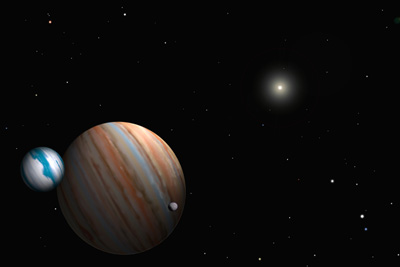Researchers from the University of Tasmania and astronomy enthusiasts from New Zealand have announced the discovery of planets using a new method - the use of gravitational lenses
Avi Blizovsky

An image taken by the Hubble Space Telescope will allow scientists to delve deeper into the details of a discovery made from Tasmania
Direct link to this page: https://www.hayadan.org.il/newplanet270505.html
Australian researchers have helped discover a new planet for the Milky Way, and they believe it's only a matter of time before more like it are discovered.
The size of the gaseous planet is a thousand times the size of the Earth and it is halfway to the center of the galaxy - at a distance of 25 thousand light years.
In the project, the researchers will use an almost unknown technique known as microlensing - using a star's gravity as a kind of magnifying glass, to help astronomers look for new planets.
Prof. John Dickey (Dickey) from the University of Tasmania, who took part in the project, said that the technique may help astronomers discover new planets that previously could not be photographed using traditional methods.
"What is special in our case is that the dwarf planet was discovered in the same way that, in principle, it is also possible to discover Earth-like planets," said Dickey.
"In recent ways, of detecting the effect of the gravitational pull of planets on their parent stars is possible, only massive stars like Jupiter can be discovered. We have struggled with our technique to try and open the door to finding Earth-like planets, and I believe that now the hope of finding them has increased."
Researchers want to use the Hubble Space Telescope to gather more information about the star and planet, which astronomers believe is the most distant from Earth ever discovered.
The discovery is the result of a project coordinated by the Paris Astrophysical Institute and involving four large telescopes in the southern hemisphere, including the University of Tasmania Campus Observatory.
Finding a planet in an amateur telescope
An international team of astronomers believe they have found a planet 15,000 light-years from Earth and is one of the most distant ever discovered.
The gaseous planet was discovered thanks to the fact that the immense gravity of its parent star disrupts the light coming from more distant stars. The way the light of the more distant star changed indicates the presence of the planet.
Two amateur astronomers from New Zealand helped find the new world using "backyard telescopes", showing that almost anyone can be a planet hunter.
Gravitational lensing is formed when a massive object like a star crosses in front of another star shining in the background. The gravity of the closer object bends the light from the more distant object and magnifies it like a lens. Here on Earth we see the stars become bright as the lens crosses their corner and then dim as the lens moves.
On March 17, 2005, Andrzej Udalski, professor of astronomy at the University of Warsaw, and lead scientist in the Optical Gravitational Lensing Experiment (Ogle) project, predicted that such an event was going to happen near the center of our galaxy.
A month later, when more and more stars became hundreds of meters brighter, astronomers participating in the Ogla project and a competing project - Microlensing to locate objects - observed a new pattern - rapid disturbances in the brightness of light that can only be explained by another object crossing close to the nearest star - a planet.
"There is no doubt that the star in the foreground has a planet, causing the anomaly we see," said Andrew Gould, from Ohio University.
Know planets outside the solar system
For the first news on CNN
For the second news - on the BBC
https://www.hayadan.org.il/BuildaGate4/general2/data_card.php?Cat=~~~172050134~~~54&SiteName=hayadan
